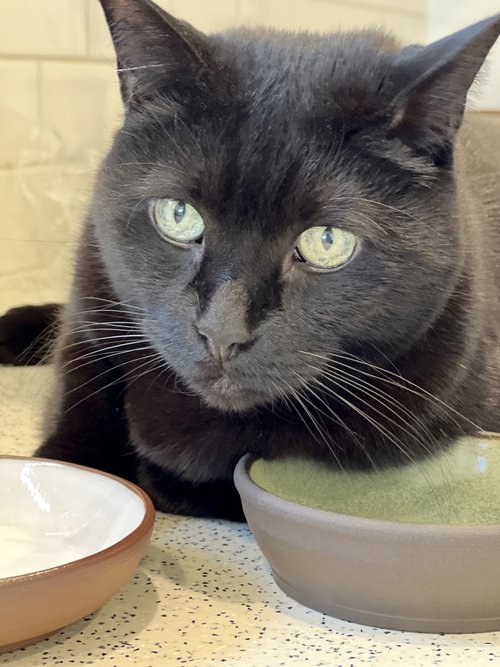Addressing Chronic Pain In Our Pets

It can be so difficult to see your pet slowing down and worrying about their comfort. Chronic pain, especially associated with degenerative orthopedic conditions, is a major contributor to declining quality of life for our pets. Upper Arlington Veterinary Hospital is eager to share new products & services designed to help keep your pet moving, happy & back to doing the things they want to do!
Acupuncture
Acupuncture is an ancient oriental medical technique involving the specific placement of needles to assist the body in healing itself. It is a broader & more holistic way to look at health, as well as the physical complaints and ailments that develop when that wellbeing breaks down.
It is unclear exactly how the ancient Chinese mapped the 14 meridians over the body’s surface or determined their associations with internal organs.
Needle insertion at certain points along these channels is thought to alter the flow of energy to correct imbalances.
This can alleviate symptoms of chronic metabolic illness and is excellent for pain associated with degenerative joint disease or neurologic disorders. It can improve non-specific signs in cancer patients, including poor appetite, nausea & lethargy. Acupuncture may also lessen anxiety in pets with behavioral concerns.
Acupuncture is generally free of side effects but must be administered by a licensed veterinarian with additional training in Chinese techniques. It will not interfere with existing therapies or medications and can be integrated with conventional Western medicine to manage a variety of conditions.
Dr. Beth Stafford has been an amazing addition to the UAVH family, bringing her expertise in Eastern medicine & acupuncture to our practice.
An initial acupuncture consultation with Dr. Stafford will include a review of your pet’s medical history, and assessment of your pet from an Eastern medicine perspective. This appointment will take about 45-60 minutes, which includes a 20-30 minute needling.
Much like physical therapy, acupuncture is most effective after multiple sessions & with consistent use. Dr. Stafford recommends three (3) weekly sessions after her initial assessment. Re-evaluation of your pet’s response will then help determine the frequency of future treatments.
Solensia™ (frunevetmab)
Osteoarthritis (OA), or degenerative joint disease, is a common condition in veterinary patients. It is the number one source of chronic pain and can cause reduced mobility, lameness, stiffness, and muscle loss. These signs are generally easier to recognize in dogs – they have trouble with stairs or jumping on the couch, prefer shorter walks or may be reluctant to chase their favorite ball. Cats are much less obvious creatures, and do not always display clear signs of discomfort. They may display more subtle behavioral changes, like eliminating outside the litterbox, irritability, hiding or overgrooming.
Studies suggest that over 90% of cats over the age of 12 are suffering from OA, yet only 8-10% receive any treatment for this condition. Furthermore, most historical treatment options have been developed for safety & efficacy in dogs only. OA is not curable, but Solensia™ is a safe & effective new breakthrough for our feline friends.
Solensia™ is the first and only FDA-approved therapy to address the pain associated with OA in cats. Nerve growth factor (NGF) has been identified as an important mediator of inflammation. NGF is produced by damaged tissues and then binds to pain receptors, starting a cycle of sensitization & discomfort. Monoclonal antibodies (mAbs) are highly specific molecules that can be used to neutralize mediators like NGF. Solensia™ is a mAb that targets NGF, preventing binding and interrupting the pain pathway.
Solensia™ is an injection, administered by our experienced staff and is recommended for monthly use. 77% of cat owners reported improvement after three (3) monthly injections, but an increase in mobility can be seen after a single treatment. Side effects are minimal but may include tenderness or itching at the injection site and vomiting.
Check out these links, including an interactive tool designed to help determine whether your cat may be showing signs of OA.
https://www.zoetispetcare.com/products/solensia
https://www.zoetispetcare.com/checklist/osteoarthritis-checklist-cat
Our Patients, Special Pets, Real Results!
Meet Kira


Kira is a 12.5-year-old hound mix who began experiencing intermittent non-weight bearing lameness of her right forelimb. Her physical exam revealed moderate neck pain and loss of muscle mass in the right shoulder. After anti-inflammatories and pain medications failed to help, she visited orthopedic and neurologic specialists who diagnosed cervical myelopathy, or compression of the spinal cord and nerves in the neck. Since treating the condition would likely require aggressive surgery, her owners decided instead to focus on Kira's comfort and quality of life.
However, medications continued to disappoint - Kira was moving gingerly, guarding her neck/head, and continued to limp. She was clearly struggling, but not for long...
After an acupuncture consultation, she has received needling sessions every 1-2 weeks. Her results have been nothing short of spectacular! Kira’s lameness has resolved and she is back to taking long walks with her family. Free from neck pain, she keeps her nose to the ground and investigates every smell out there, as any good hound should!
Meet Patty


Patty is a 13.5-year-old domestic shorthair cat who visited us after consistently acting agitated at home. Her owners noted an increase in biting behavior, as well flinching whenever they pet her back end. During her physical exam, Patty would growl/vocalize and swat when her lower back and pelvic area were palpated.
Hyperpathia (an abnormally painful reaction) in the spine of an older cat is often the result of degenerative changes to the vertebrae, discs, nerve roots and/or joints.
Her behavior improved with trials of two different pain medications, but both drugs can cause excessive sedation. Switching to an off-label non-steroidal anti-inflammatory drug (NSAID) yielded positive results, helping Patty feel friskier and more playful at home, but the potential for kidney, liver, or gastrointestinal side effects with NSAIDs must be carefully monitored in cats.
We determined that Patty was an ideal candidate for a Solensia™ trial and we're thrilled to share her experience was overwhelmingly positive! She was acting like a kitten within 24 hours of her first injection and her family reports that she remains active, mobile, and comfortable, even as the time for her next scheduled injection nears. Everyone in Patty's house better remember to put away their dishes these days because Patty spends more time atop the kitchen counter than she has in years!
Please reach out if you feel your dog or cat may benefit from one of these new therapies. We look forward to discussing your concerns, performing a thorough exam and developing a plan for your family. We are very excited to offer new ways to improve your pet’s quality of life, comfort and well-being.





